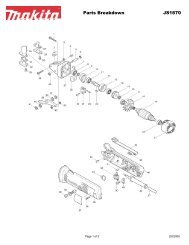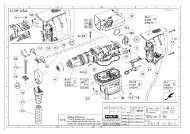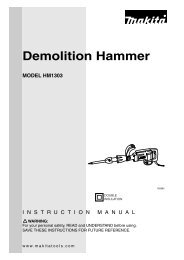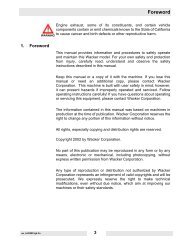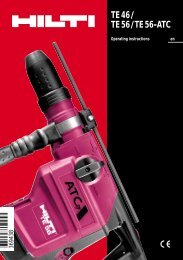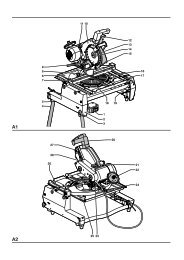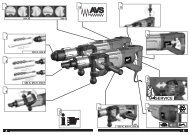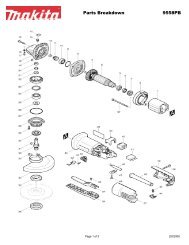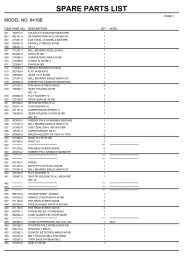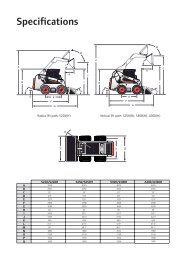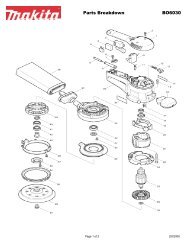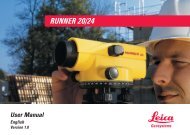Manual - RAN Hire and Sales Ltd
Manual - RAN Hire and Sales Ltd
Manual - RAN Hire and Sales Ltd
Create successful ePaper yourself
Turn your PDF publications into a flip-book with our unique Google optimized e-Paper software.
5. Use of an attachment not recommended<br />
or sold by the battery charger manufacturer<br />
may result in a risk of fire, electric<br />
shock, or injury to persons.<br />
6. To reduce risk of damage to electric plug<br />
<strong>and</strong> cord, pull by plug rather than cord<br />
when disconnecting charger.<br />
7. Make sure cord is located so that it will<br />
not be stepped on, tripped over, or otherwise<br />
subjected to damage or stress.<br />
8. An extension cord should not be used<br />
unless absolutely necessary. Use of<br />
improper extension cord could result in a<br />
risk of fire <strong>and</strong> electric shock. If extension<br />
cord must be used, make sure:<br />
a. That pins on plug of extension cord<br />
are the same number, size, <strong>and</strong> shape<br />
as those of plug on charger;<br />
b. That extension cord is properly wired<br />
<strong>and</strong> in good electrical condition;<br />
c. That wire size is at least as large as<br />
the one specified in the table below.<br />
Table 1: RECOMMENDED MINIMUM AWG SIZE FOR EXTENSION CORDS FOR BATTERY CHARGERS<br />
Length of Cord (Feet) 25 50 100 150<br />
AWG Size of Cord 18 18 18 16<br />
9. Do not operate charger with damaged<br />
cord or plug - replace them immediately.<br />
10. Do not operate charger if it has received a<br />
sharp blow, been dropped, or otherwise<br />
damaged in any way; take it to a qualified<br />
serviceman.<br />
11. Do not disassemble charger or battery<br />
cartridge; take it to a qualified serviceman<br />
when service or repair is required, Incorrect<br />
reassembly may result in a risk of<br />
electric shock or fire.<br />
12. To reduce risk of electric shock, unplug<br />
charger from outlet before attempting any<br />
maintenance or cleaning. Turning off controls<br />
will not reduce this risk.<br />
13. The battery charger is not intended for<br />
use by young children or infirm persons<br />
without supervision.<br />
14. Young children should be supervised to<br />
ensure that they do not play with the battery<br />
charger.<br />
15. If operating time has become excessively<br />
shorter, stop operating immediately. It<br />
may result in a risk of overheating, possible<br />
burns <strong>and</strong> even an explosion.<br />
16. If electrolyte gets into your eyes, rinse<br />
them out with clear water <strong>and</strong> seek medical<br />
attention right away. It may result in<br />
loss of your eyesight.<br />
ADDITIONAL SAFETY RULES FOR CHARGER &<br />
BATTERY CARTRIDGE<br />
1. Do not charge Battery Cartridge when<br />
temperature is BELOW 10°C (50°F) or<br />
ABOVE 40°C (104°F).<br />
2. Do not attempt to use a step-up transformer,<br />
an engine generator or DC power<br />
receptacle.<br />
6



